The Featured Creatures collection provides in-depth profiles of insects, nematodes, arachnids, and other organisms relevant to Florida. These profiles are intended for the use of interested laypersons with some knowledge of biology as well as academic audiences.
Introduction
The New World screwworm (NWS), Cochliomyia hominivorax (Coquerel) (Diptera: Calliphoridae) (Figure 1), also known as the primary screwworm, Gusano Barrenador del Ganado (GBG), or cattle bore worm, is the only parasitic representative of the genus Cochliomyia, containing three other species, C. macellaria, C. aldrichi, and C. minima (Whitworth 2006). The other species of flies in this genus are primarily necrophagous, utilizing dead animal carcasses or animal material as larval habitat, and do not feed on living tissue like NWS larvae. Historical losses to the United States livestock industry, as well as its threat to wildlife, companion animals, and humans, incentivized an eradication program beginning in the 1950s and using a process called Sterile Insect Technique (SIT). This program led to the New World screwworm’s indigenous eradication in 1966 (Krafsur et al. 1987). Today, NWS is still an endemic pest in countries such as Jamaica and Cuba and numerous countries in South America. An isolated incursion of NWS in Florida occurred in October 2016 on Big Pine Key in Florida, where primarily endangered Key deer (Odocoileus virginianus clavium), and a few domestic and wild animals, were found with active infestations (USDA-APHIS 2017). Using SIT, USDA-APHIS declared the successful re-eradication of NWS from Florida on March 23, 2017.
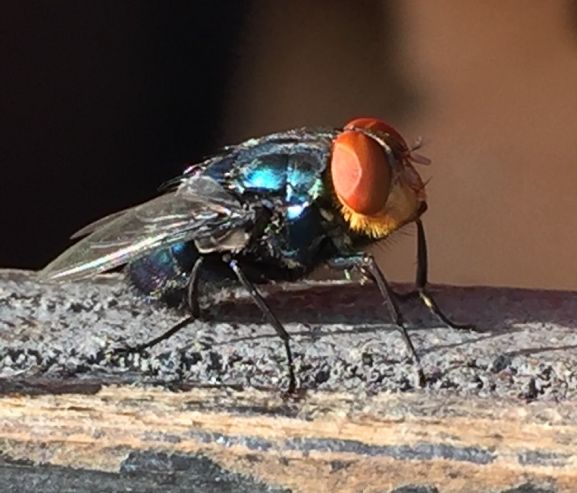
Credit: USDA
Distribution
The distribution of Cochliomyia hominivorax prior to 2023 was primarily south of the Darién gap in southern Panama, including much of South America and on a few Caribbean islands, notably Jamaica and Cuba (Welch 2016). For a detailed distribution map prior to 2023, please refer to the CABI Screwworm Datasheet at cabidigitallibrary.org. In July 2023, infestations of NWS in animals were reported in Costa Rica north of the biological barrier formed by the Darién gap in Panama. Throughout 2024, other reports of NWS infestations came from Central American countries including Nicaragua and Honduras, as well as Mexico. For an official, updated map of NWS infestations in Central America and Mexico, please refer to New World Screwworm Outbreak in Central American and Mexico, at aphis.usda.gov.
Description
The adult New World screwworm (NWS), Cochliomyia hominivorax, is a metallic blue to blue-green fly, with reddish-orange eyes, and an orange head (Figure 1). Differentiation of NWS with a closely related species, Cochliomyia macellaria, the secondary screwworm, challenged scientists prior to eradication efforts. Both adult flies have three parallel dark stripes that run down the dorsal surface of the thorax (i.e., the middle body region between the head and abdomen). In the secondary screwworm, these three stripes start at the head and run down the length of the thorax. In NWS, the middle stripe does not start at the head but further down the thorax. However, this feature can be unreliable for identification because these three stripes fade shortly after the fly has died. A more reliable method for differentiation between NWS and the secondary screwworm is a small patch of hairs located between the eyes and a ridge of dark bristles just above the antennae (Whitworth 2006) (Figure 2). An adult NWS is roughly 2 to 3 times the size of an adult house fly.
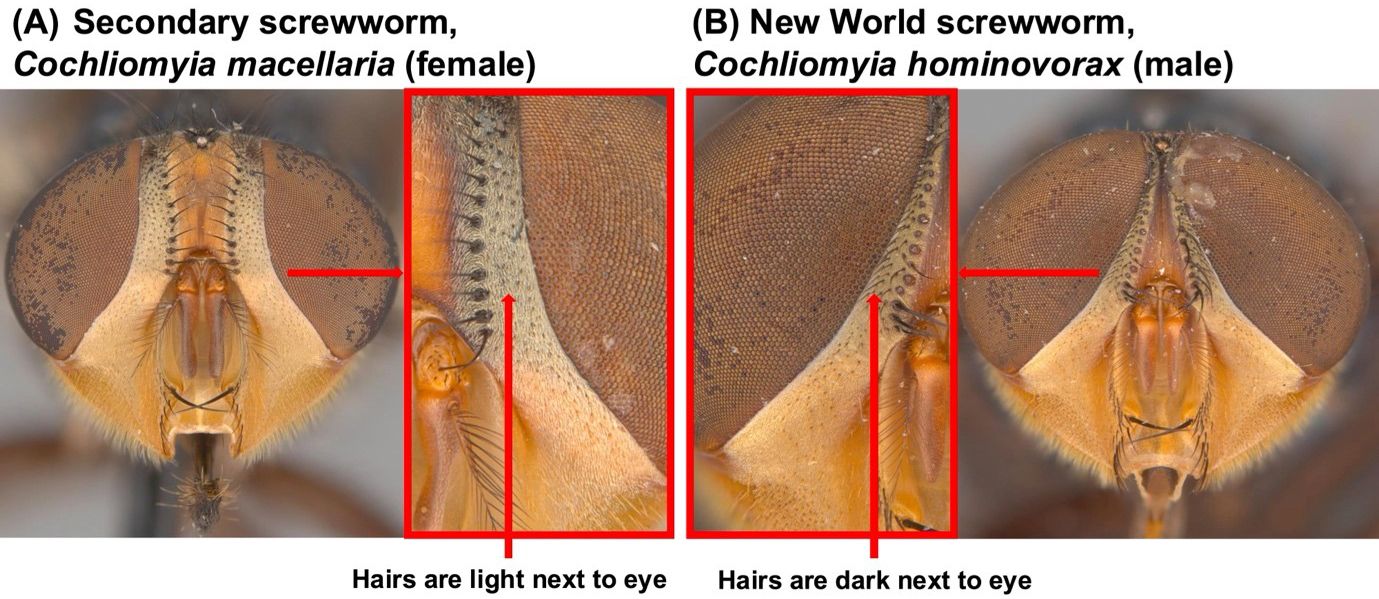
Credit: Lyle Buss and Edwin R. Burgess IV, UF/IFAS
Larvae (Figure 3) found in an animal wound can reach 17 mm in length (2/3 of an inch). The most mature larvae develop spines that protrude from the body and wrap around in a spiral, hence the name screwworm (Hall 1991). Identification of the larvae is based largely on the presence or absence of dark internal breathing tubes and requires a trained entomology specialist for confirmation (Figure 4).
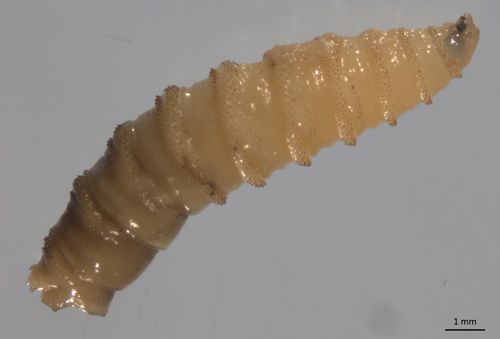
Credit: Heather Stockdale Walden, UF/IFAS
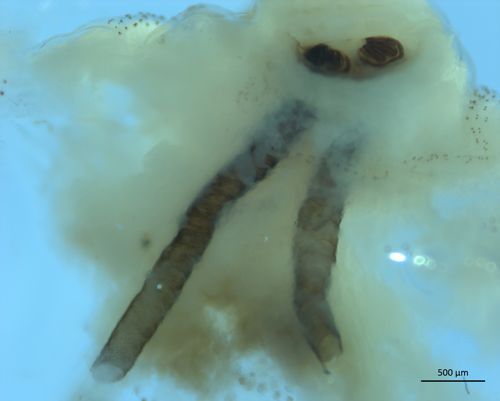
Credit: Heather Stockdale Walden, UF/IFAS
Life Cycle
New World screwworm (NWS) infestations begin when an adult female fly deposits eggs in or near an existing wound on an animal. Such wounds can be as small as a tick bite. A single adult female can lay as many as 350 eggs, but not all eggs are deposited in a single wound. The fly only lays its eggs on living animals, differentiating it from all other blow flies in the Americas. These eggs hatch and the larvae feed on the healthy tissue, causing the wound to enlarge and deepen. Their activity can draw in more adult flies, including those of other blow fly species, as well as the secondary screwworm, that can deposit more eggs. Once larvae are fully formed, they crawl out of the wound and drop to the ground, where they pupate in leaf litter or just under the surface of the soil. Adult flies will emerge from the pupae typically after approximately 7–10 days but can take up to a couple of months when soil temperatures are low. Pupae will die when soil temperatures get below 8C (46°F) (WOAH 2013). Under temperate environmental conditions (i.e., 22°C or 71.6°F), NWS can complete its life cycle in 24 days (Laake et al. 1936), while suboptimal conditions can extend the lifecycle to 2–3 months (WOAH 2013). In its tropical native environment (i.e., 29°C or 84.2°F), the life cycle can be completed in as few as 18 days. NWS is not capable of overwintering in areas that experience low temperatures or extended dry periods. Interestingly, most screwworm females only mate once, making them an ideal candidate for the sterile insect technique described below.
Veterinary, Conservation, and Economic Importance
Adult New World screwworms (NWS), like all blow flies, do not bite humans or animals. Rather, NWS larvae feed on animals’ existing cuts, scrapes, and other wounds, preventing wounds from healing and greatly exacerbating the damage even when wounds start very small. Screwworms can infest all types of mammals and other warm-blooded animals, including livestock, wildlife, companion animals, and even humans, although they are rarely found in birds. Wild and captive-raised deer also can be affected. Infestation generally occurs at the site of a recent, existing wound, such as a scrape, lesion, or even tick feeding site, but also from castration, dehorning, branding, ear tagging, shearing, or wounds from birth (e.g., umbilicus of calf, female genitals). In addition, mucous membranes and antlers that are shedding velvet are potential sites where infestation can occur.
Because pets can become infested, it is important that owners watch any wounds that do not heal properly. Larvae may not be apparent, and a veterinarian should be consulted in such situations. Examination of wildlife is challenging and should be conducted by professionals. If you suspect an infestation, you should contact the Florida Department of Agricultural and Consumer Services or the Florida Fish and Wildlife Commission personnel at FDACS.gov. Please also see the end of this publication for more contact information.
The early stages of an infestation are difficult to detect (Figure 5). Wounds that are not properly healing or that are draining excessively should be inspected for larvae. Animals may show discomfort and become lethargic when infested. Wounds that are not treated can become life threatening in 7 to 14 days. Any suspected or discovered case of larvae in a live host must be reported to the Florida Department of Agriculture and Consumer Services. Infested animals should not be moved to ensure that flies are not moved to uninfested areas.
In 2016 approximately 14% (135 animals) of the endangered Key deer were euthanized or died from NWS infestations during an outbreak in the Florida Keys. Infested Key deer were first reported in June with peak infestations occurring in October, and the last case occurred in January 2017. The majority of the mortalities (82%) were male, and the outbreak corresponded with the rutting season, when males spar and receive cuts and abrasions that became entry points for NWS egg laying.
Eradication of NWS from the Keys was due to a rapid and coordinated response from US Fish and Wildlife Service, US Department of Agriculture, Florida Department of Agriculture and Consumer Services, Florida Fish and Wildlife Commission, and other state and federal agencies. These agencies took a multipronged approach to prevent the spread of NWS and to eradicate it from the United States. To eliminate the flies from the Florida Keys, the response team deployed sterile flies to prevent NWS population growth and used dewormer as a treatment preventative in Key deer (Parker et al. 2020).
To prevent the spread of NWS during the outbreak, an Agricultural Emergency was declared in Monroe County, Florida, which prohibited the movement of all nonhuman animals in or out of the quarantine area without inspection. All vehicles entering or leaving the Keys were inspected 24 hours a day from October 2016 until March 2017. More than 17,000 animals were inspected and >500 deployments of federal or state staff were activated. Public education and outreach were also credited with alerting residents and visitors to the ongoing outbreak, which helped with quarantine compliance and the detection of infested deer (Hennessey et al. 2019).
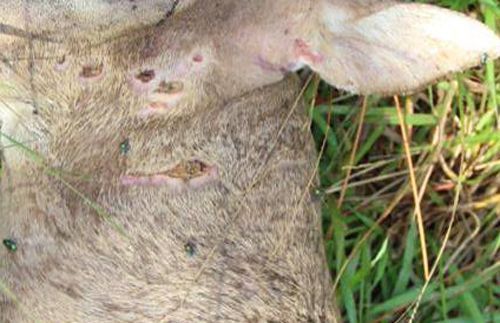
Credit: Samantha Gibbs, US Fish and Wildlife Service
Management
The following information was provided by Florida Department of Agricultural and Consumer Services (FDACS) in 2025: Anyone who suspects the presence of screwworms or who has questions or concerns can contact (phone during office hours) — 1-850-410-0900, (phone after hours) — 1-800-342-5869, (email) — RAD@FDACS.gov, (online reporting) — www.FDACS.gov/RAD.
Treatment of the Individual
Consult with your veterinarian for the appropriate treatment. Remove with forceps and clean the wound. If you suspect screwworm (the presence of flesh-eating larvae is the surest sign), collect the larvae in alcohol (70% or greater) and give them to your veterinarian immediately. Your veterinarian will submit the sample to FDACS. Samples must be shipped to the USDA's National Veterinary Services Laboratory for identification. After removal, infestations often are treated either systemically with parasiticide or topically with a pesticide to kill any larvae that may not have been removed and to reduce the likelihood of reinfestation.
It is exceedingly important to report any infestations to Florida Department of Agriculture and Consumer Services (FDACS). They will assist animal owners in the treatment of infested animals and remove flies from the vicinity. The New World screwworm (NWS) can quickly devastate flocks or herds and, in the past, has cost the US livestock industry billions of dollars. A reported case will not result in herd depopulation but will allow animal health officials to take steps on your ranch and surrounding areas to help you protect your herd and Florida’s animal population.
Several traps exist for monitoring NWS adults; these are generally sticky traps baited with an attractant lure (Swormlure-5) (Broce et al. 1977; Hickner et al. 2023). These traps are often used to monitor for the flies to ensure that sterile insect programs are working to provide area-wide control of screwworms (Vreysen et al. 2007).
Following initial colonization of a wound by the New World screwworm, other blow fly species may be attracted to the wound (Figures 5 and 6). These blow flies may lay eggs in the same wound, and thus one may see other types of blow fly adults and their larvae on the animals, particularly as the animal's health declines.
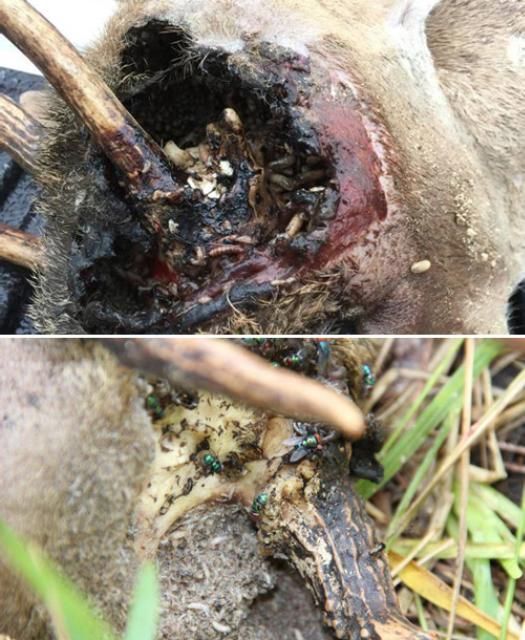
Credit: Samantha Gibbs, US Fish and Wildlife Service
Historical Management and Eradication
Prior to the 1950s and '60s, New World screwworms (NWS) were a major economic burden to the production and treatment of livestock in the southwestern United States. In the early 1930s, infested animals were moved to the southeastern United States and became established in many southeastern states, including Florida. In the late 1950s, the USDA began implementing an eradication strategy based on releasing sterile male flies in the environment along with monitoring animals continuously to reduce infestations. The sterile males, released in numbers far exceeding the normal population levels, competed with fertile males to mate with females. Because females only mate once, any fly that mates with a sterile male will be unable to produce offspring, which results in the eventual eradication of the fly.
Using sterile male flies, NWS was eradicated in Florida in 1960. The USDA announced the eradication of NWS from the United States; however, it was not until 1983 that the United States was free from ongoing incursions of flies from Mexico (Novy 1991). In 2016, there was a brief and isolated incursion of NWS at Big Pine Key in Florida, which was eradicated with the sterile insect technique by March 2017. An ongoing outbreak of NWS in 2024 from the barrier zone in the Darién gap has led to NWS infestations in Central America and Mexico.
Management of the Current Outbreak
The United States Department of Agriculture is currently expanding its sterile insect capabilities, notably by building a new distribution facility at Moore Air Base located northwest of Mission, Texas. The Panama-United States Commission for the Eradication and Prevention of Screwworm Infestation in Livestock (COPEG) has moved the barrier zone further north in Mexico to limit northward incursions of New World screwworm. For more information on these efforts, please see the “Current Situation” page on COPEG’s website, copeg.org, and the USDA’s New World Screwworm Domestic Readiness and Response Policy Initiative at USDA.gov.
Selected References
Broce AB, Goodenough JL, Coppedge JR. 1977. A wind oriented trap for screwworm flies. Journal of Economic Entomology 70: 413–416. https://doi.org/10.1093/jee/70.4.413
Hall MJR. 1991. Screwworm flies as agents of wound myiasis. World Animal Review: Special issue—New World screwworm response to an emergency. Oct: 08–17.
Hennessey MJ, His DJ, Davis JS, Delgado AH, Allen HA, Jandegian CM, Skoda SR, Watts KG, Gibbs SE, Powell B, Welch JB. 2019. Use of a multiagency approach to eradicate New World screwworm flies from Big Pine Key, Florida, following an outbreak of screwworm infestation (September 2016–March 2017). Journal of the American Veterinary Medical Association 255(8): 908–914. https://doi.org/10.2460/javma.255.8.908
Hickner PV, Pacheco L, Duke SE, Ortiz CS, Welch JB, Phillips PL, Arp AP. 2023. A new formulation of screwworm fly attractant with reduced hazardous chemicals and transport restrictions. Journal of Medical Entomology 60(4): 631–636. https://doi.org/10.1093/jme/tjad043
Krafsur ES, Whitten CJ, Novy JE. 1987. Screwworm eradication in North and Central America. Parasitology Today 3(5): 131–137. https://doi.org/10.1016/0169-4758(87)90196-7
Laake EW, Cushing EC, Parish HE. 1936. Biology, of the primary screwworm fly, Cochliomyia americana, and a comparison of its stages with those of C. macellaria. USDA Tech. Bull. No. 500. Washington, D.C., USDA.
Novy JE. 1991. Screwworm control and eradication in the southern United States of America. World Animal Review: Special issue: New World screwworm response to an emergency. Oct: 18–27.
Parker ID, Lopez RR, Silvy NJ, Pierce BL, Watts KG, Myers EP, Gibbs SEJ, Davis DS, Beaver JT, Lund AA. 2020. Florida key deer abundance and recovery following New World screwworm infestation. Southeastern Naturalist 19(20): 179–191. https://doi.org/10.1656/058.019.0201
United States Department of Agriculture-Animal and Plant Health Inspection Service (USDA-APHIS). 2017. Final report for the APHIS veterinary services response to the 2016–2017 outbreak of New World screwworm (NWS) in Florida. (May 30, 2017). https://www.aphis.usda.gov/sites/default/files/public-nws-usdaaphis-final-report.pdf
Vreysen MJB, Robinson AS, Hendrichs J. 2007. Area-wide Control of Insect Pests: From Research to Field Implementation. Springer, Dordrecht, the Netherlands. 789 pp. https://doi.org/10.1007/978-1-4020-6059-5
Welch JB. (2016). Cochliomyia hominivorax (New World screwworm) datasheet. CABI Invasive Species Compendium. (04 October 2016). https://doi.org/10.1079/cabicompendium.11753
World Organization for Animal Health (WOAH). 2013. Screwworm (Old World and New World) — Aetiology, Epidemiology, Diagnosis, Prevention, and Control References. Accessed Jul 15, 2025. https://www.woah.org/fileadmin/Home/eng/Animal_Health_in_the_World/docs/pdf/Disease_cards/SCREWWORM.pdf
FDACS Links and Contacts
- 1-833-Animal0 (Toll Free)
- Report online or by email: www.FDACS.gov/RAD; www.FDACS.gov/NWS
Wildlife cases — Notify Florida Fish and Wildlife Conservation Commission at #FWC or 888-404-FWCC (Toll Free)
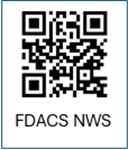
Credit: undefined